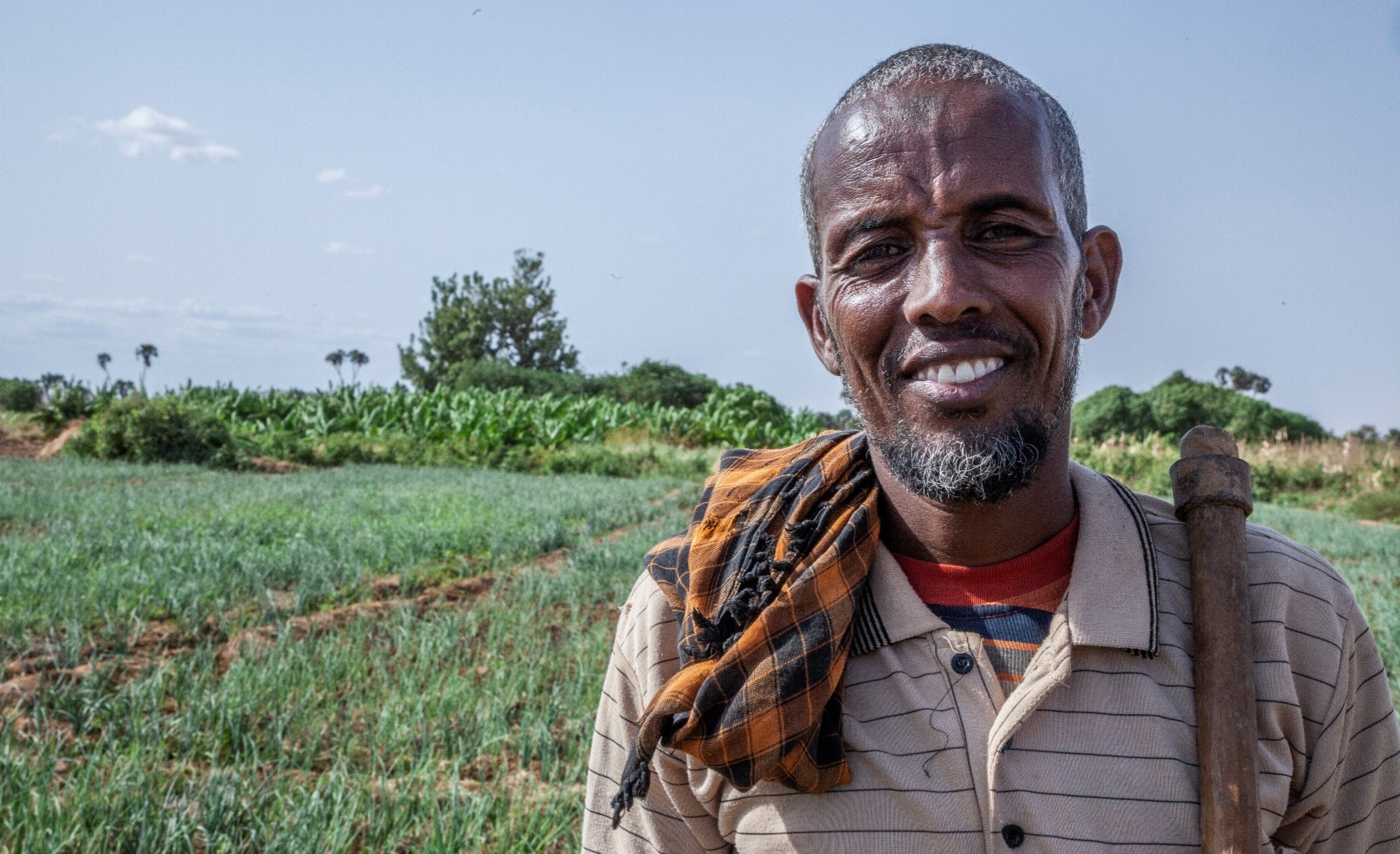Ethiopia
Ethiopia

An Ethiopian farmer harvests onions near Melkadida camp – home to Somali refugees – where he shares his land with farmers from the refugee community.
Content of this page:
1. Description of the refugee situation
2. Ethiopia's response to the refugee situation
3. Steps towards meeting the objectives of the Compact
1. Description of refugee situation
As of 31 March 2022, the Government Refugee and Returnees Service (RRS) and UNHCR have registered 844,589 refugees. With a projected national population of 102.9 million, refugees make up about 1% of the country’s population. The majority of refugees live in the regional states of Afar, Benishangul-Gumuz, Gambella, Tigray, Somali and in capital Addis Ababa. Most refugee-hosting regions lag behind on key development indicators and need increased support for host communities and growing refugee populations.
|
Location |
Refugee Population |
|
Addis Ababa |
71,596 |
|
Afar |
56,262 |
|
Benishangul-Gumuz |
72,650 |
|
Gambella |
361,741 |
|
Somali |
236,524 |
|
SNNPR |
4,938 |
|
Tigray |
36,841 |
|
Oromia |
4,037 |
| Total Refugee Population | 844,589 |
as of April 2022
Refugees residing in Ethiopia originate from South Sudan (46%), Somalia (28%), Eritrea (19%), and Sudan (6%), with an additional small number of other nationalities (1%).
Find live data, information and fact sheets on the refugee situation in Ethiopia on the UNHCR Operational Portal as well as Global Focus.
2. Ethiopia's response to the refugee situation
Ethiopia has a long-standing history of hosting refugees. It maintains an open-door policy and allows humanitarian access and protection to those seeking asylum on its territory. In 2004, a national Refugee Proclamation was enacted based on the international and regional refugee conventions to which Ethiopia is a party (1951 Convention relating to the Status of Refugees, and its 1967 Protocol and the 1969 OAU Convention).
At the Leaders’ Summit in September 2016 Ethiopia made nine pledges on Education, Out of Camp Policy, Documentation, Local Integration, Basic Social Services and Work and Livelihoods (four pledges) to respond to the needs of refugees in a more comprehensive and sustainable manner. Ethiopia was an early leader in pursuing the Comprehensive Refugee Response Framework (CRRF). CRRF was officially launched in Ethiopia on 28 November 2017. After the endorsement of the Global Compact on Refugees (GCR) in 2018, Ethiopia continued its commitment with the adoption of a new Refugee Proclamation (Proclamation No. 1110/2019) in January 2019 granting a wide-ranging set of additional rights to refugees. To complement the Proclamation three directives and a guideline came into effect on 30 December 2019:
- Directive to Determine the Conditions for Movement and Residence of Refugees Outside of Camps, Directive No.01/2019.
- Directive to Determine the Procedure for Refugees Right to Work, Directive No. 02/2019.
- Refugees and Returnees Grievances and Appeals Handling Directive, Directive 03/2019.
- Environment and Social Management Guidelines.
Also in 2019, at the first Global Refugee Forum (GRF) Ethiopia has made four additional pledges on Jobs and Livelihoods, Education, Protection and Energy. As a midterm-review of the pledge progress, a National Stock Taking Workshop was held in December 2021. The event offered the opportunity to partners working together on the implementation of Ethiopia’s pledges to evaluate progress and take stock of the efforts made.
3. Steps towards meeting the objectives of the Compact
Ethiopia continues to facilitate the response of the international community in seeking development solutions. Humanitarian and development partners have been working hand in hand to support the Government of Ethiopia on comprehensive responses to both refugees and hosting communities in Ethiopia.
Partners:
Government Agencies: Refugees and Returnees Service (RRS), Immigration, Nationality and Vital Events Agency (INVEA), Ministry of Women and Social Affairs, Ethiopian Human Rights Commission, Ministry of Agriculture, Ministry of Skills, and labor, Federal TVET Agency, TVET Colleges, TVET Bureaus, Job Creation Agency, Environmental Protection Agency (EPA), Ministry of Water and Energy and Ethiopian Electric Utility (EEU)
Donors: United States - Bureau of Population, Refugees and Migration (PRM), Foreign, Commonwealth and Development Office (FCDO), European Union Trust Fund (EUTF), Netherlands (Prospect Partnership), World Bank, IKEA Foundation, Federal Ministry for Economic Cooperation and Development (Germany), Norwegian Agency for Development Cooperation (Norad), World Bank, Spanish Agency for International Development Cooperation (AECID) and IFC.
UN Agencies: UNHCR, WFP, ILO, UNICEF, UNWOMEN and UNFPA.
Projects/NGOs: Save the Children, Plan International, Jesuit Refugee Service (JRS), International Rescue Committee (IRC), African Child Policy Forum, International Medical Corps (IMC), Rehabilitation and Development Organization (RADO), Danish Refugee Council (DRC), Norwegian Refugee Council (NRC), EU (RDPP), Farm Africa, ZOA, Women and Pastoralist Youth Development Organization (WaPydo), Concern Ethiopia, Mercy Corps, Deutsche Gesellschaft für Internationale Zusammenarbeit (GIZ), Development and Inter-Church Aid Commission (DICAC), Lutheran World Federation (LWF), Adventist Development, Relief Agency (ADRA), DCA, Comitato Internazionale per lo Sviluppo dei Popoli (CISP), Action for the Needy Ethiopia (ANE), Save the Environment Ethiopia (SEE), Natural Resource Development and Environmental Protection (NRDEP) and SHARPE.
Private Sector: Development Alternatives Incorporated (DAI)


